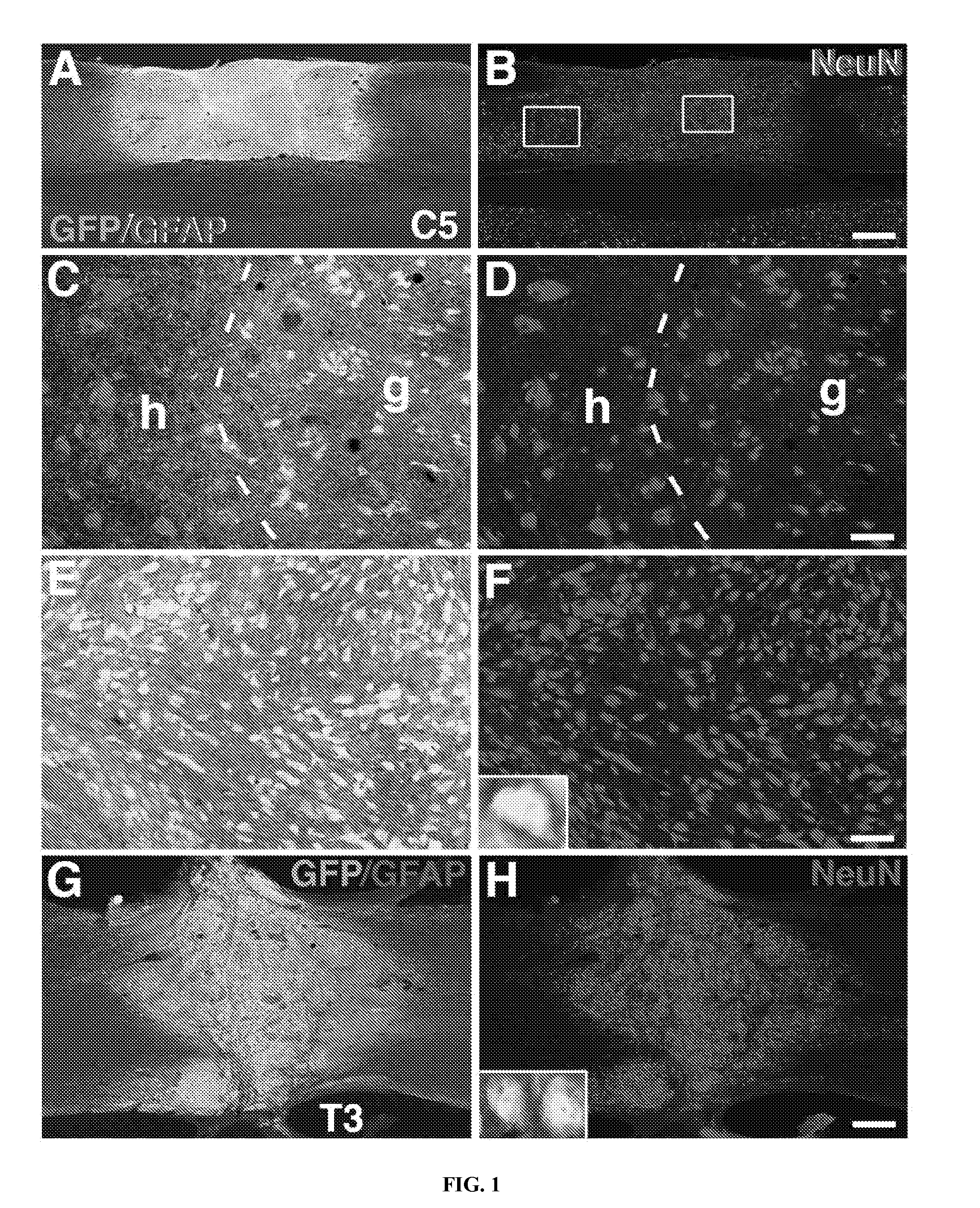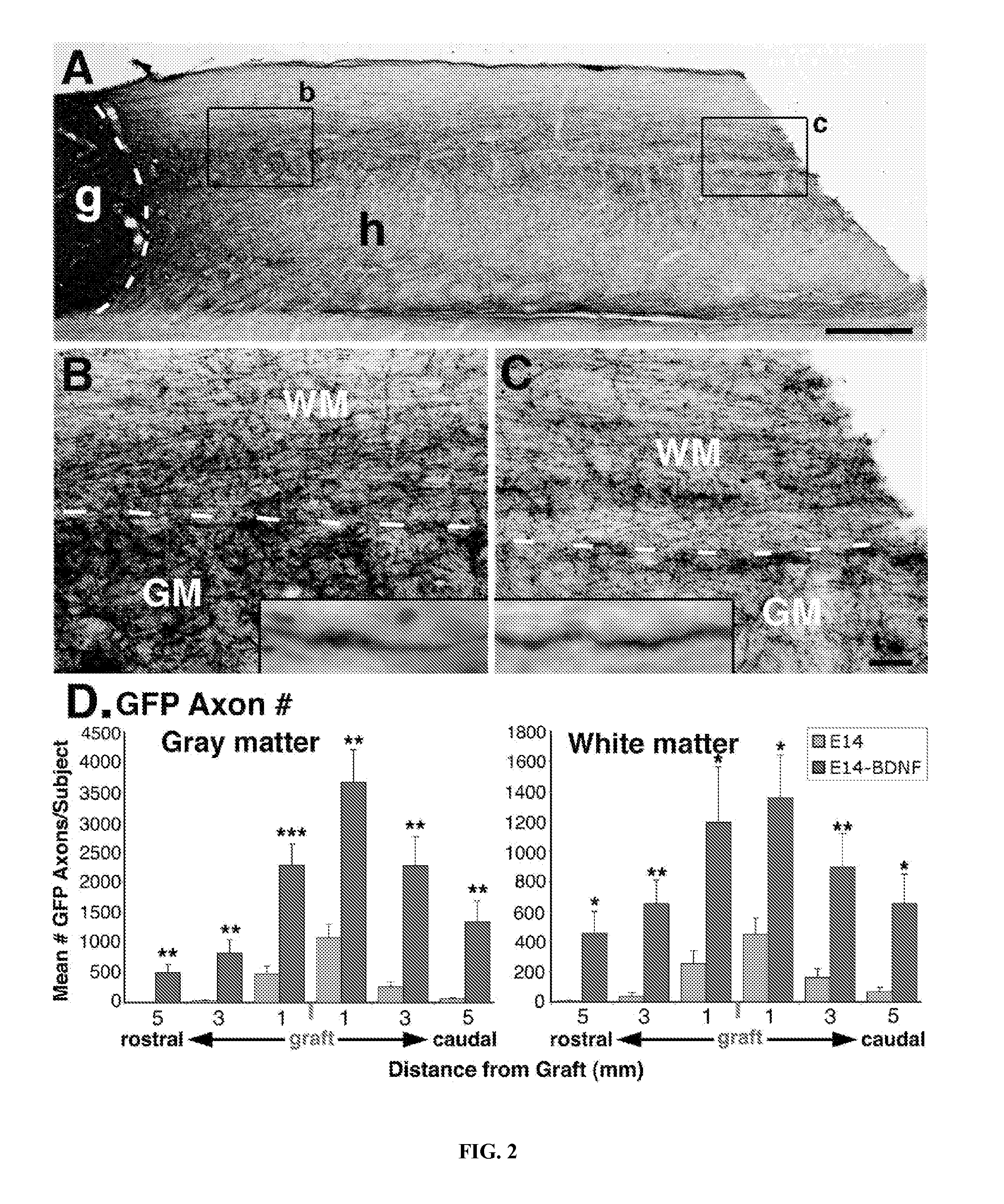Methods for Use of Neural Stem Cell Compositions for Treatment of Central Nervous System Lesions
- Summary
- Abstract
- Description
- Claims
- Application Information
AI Technical Summary
Benefits of technology
Problems solved by technology
Method used
Image
Examples
example i
Animal Model of Spinal Cord Injury
[0076]Adult female Fischer 344 rats (160-200 g, n=27) were subjects of this study. NIH guidelines for laboratory animal care and safety were strictly followed. Animals had free access to food and water throughout the study. All surgery was done under deep anesthesia using a combination (2 ml / kg) of ketamine (25 mg / ml), xylazine (1.3 gm / ml) and acepromazine (0.25 mg / ml). Adult female Fischer 344 rats underwent C5 lateral hemisection or T3 complete transection.
example ii
Preparation of Embryonic Cell Grafts
[0077]Embryonic day 14 (E14) spinal cord from transgenic Fischer 344-Tg (EGFP) rats ubiquitously express GFP under the ubiquitin C promoter and provided donor tissue for grafting (Rat Resource and Research Center, University of Missouri, Columbia, Mo.). Following C5 or T3 dorsal laminectomy, the dura was cut longitudinally and retracted. A 2-mm-long block of spinal cord was cut and removed using a combination of iridectomy scissors and microaspiration, with visual verification to ensure complete transection ventrally and laterally. E14 spinal cord from Fischer 344 rats expressing GFP was freshly dissected and dissociated.
[0078]Dissociated E14 cells were re-suspended in a fibrin matrix (25 mg / ml fibrinogen and 25 U / ml thrombin). Growth factors were added to the cell / adhesive suspension: BDNF (50 μg / ml), neurotrophin-3 (NT-3; 50 μg / ml), platelet-derived growth factor (PDGF-AA; 10 μg / ml), insulin-like growth factor 1 (IGF-1; 10 μg / ml), epidermal grow...
example iii
Grafting of Pluripotent Neural Stem Cells Derived from Embryonic Spinal Cord
[0079]Spinal cord tissue derived from genetically modified green fluorescent protein (GFP)—expressing rat embryos was grafted to the adult lesioned spinal cord. Under the ubiquitin C promoter, “green” rats express the GFP reporter gene in every cell, providing an unprecedented opportunity to track the fate, integration, extension and differentiation of grafted cells types within the inhibitory milieu of the adult injured spinal cord.
[0080]Cell suspensions of embryonic day 14 (E14) spinal cords from Fischer 344 rats expressing GFP under the ubiquitin C promoter were grafted into either acute mid-cervical (C5) lateral hemisection lesion sites or, two weeks after injury, into upper thoracic (T3) complete transection lesion sites, in non-transgenic F344 rats.
[0081]16 adult rats underwent C5 hemisection lesions and were divided into two groups. One group of 6 rats received E14 GFP-expressing grafts only (n=6), wh...
PUM
| Property | Measurement | Unit |
|---|---|---|
| Mass | aaaaa | aaaaa |
| Mass | aaaaa | aaaaa |
| Composition | aaaaa | aaaaa |
Abstract
Description
Claims
Application Information
 Login to View More
Login to View More - R&D
- Intellectual Property
- Life Sciences
- Materials
- Tech Scout
- Unparalleled Data Quality
- Higher Quality Content
- 60% Fewer Hallucinations
Browse by: Latest US Patents, China's latest patents, Technical Efficacy Thesaurus, Application Domain, Technology Topic, Popular Technical Reports.
© 2025 PatSnap. All rights reserved.Legal|Privacy policy|Modern Slavery Act Transparency Statement|Sitemap|About US| Contact US: help@patsnap.com



